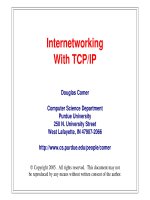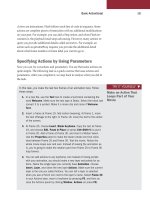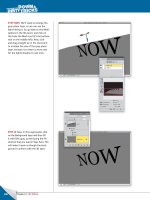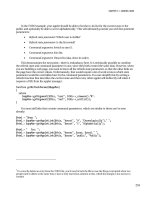Internetworking with TCP/IP- P11 ppsx
Bạn đang xem bản rút gọn của tài liệu. Xem và tải ngay bản đầy đủ của tài liệu tại đây (482.57 KB, 10 trang )
Classful
Internet Addresses
Chap.
4
4.9
IP Multicast Addresses
In
addition to
unicast delivery,
in which a packet is delivered to a single computer,
and
broadcast delivery,
in which a packet is delivered to all computers on a given net-
work, the
IP
addressing scheme supports a special form of multipoint delivery known as
multicasting,
in which a packet is delivered to a specific subset of hosts. IP multicast-
ing is especially useful for networks where the hardware technology supports multicast
delivery. Chapter
17
discusses multicast addressing and delivery in detail. For now, it
is sufficient to understand that Class
D
addresses are reserved for multicasting.
4.10
Weaknesses In Internet Addressing
Encoding network information in an internet address does have some disadvan-
tages. The most obvious disadvantage is that addresses refer to network connections,
not to the host computer:
If
a host computer moves from one network to another, its IP address
mist change.
To understand the consequences, consider a traveler who wishes to disconnect his or her
personal computer, carry it along on a trip, and reconnect it to the Internet after reach-
ing the destination. The personal computer cannot be assigned a permanent IP address
because an
IP
address identifies the network to which the machine attaches. Chapter
19
shows how the
IP
addressing scheme makes
mobility
a complex problem.
Another weakness of the classful addressing scheme is that when any class
C
net-
work grows to more than
255
hosts, it must have its address changed to a class
B
ad-
dress. While this may seem like a minor problem, changing network addresses can
be
incredibly time-consuming and difficult to debug. Because most software is not
designed to handle multiple addresses for the same physical network, administrators
cannot plan a smooth transition in which they introduce new addresses slowly. Instead,
they must abruptly stop using one network address, change the addresses of all
machines, and then resume communication using the new network address.
The most important flaw in the internet addressing scheme will not become fully
apparent until we examine routing. However, its importance warrants a brief introduc-
tion here. We have suggested that routing will be based on internet addresses, with the
netid portion of an address used to make routing decisions. Consider a host with two
connections to the internet. We know that such a host must have more than one
IP
ad-
dress. The following is true:
Because routing uses the network portion of the IP address, the path
taken
by
packets traveling to a host with multiple IP addresses
depends on the address used.
Sec.
4.10
Weaknesses In Internet Addressing
69
The implications are surprising. Humans think of each host
as
a single entity and want
to use a single name. They are often surprised to find that they must learn more than
one name and even more surprised to find that packets sent using multiple names can
behave differently.
Another surprising consequence of the internet addressing scheme is that merely
knowing one
IP
address for
a
destination may not be sufficient; it may
be
impossible to
reach the destination using that address. Consider the example internet shown in Figure
4.2.
In
the figure, two hosts,
A
and
B,
both attach to network
1,
and usually communi-
cate directly using that network. Thus, users on host
A
should normally refer to host
B
using
IP
address
I,.
An
alternate path from
A
to
B
exists through router
R,
and is used
whenever
A
sends packets to
IP
address
I,
(B's address on network
2).
Now suppose
B's connection to network
1
fails, but the machine itself remains running (e.g., a wire
breaks between
B
and network
1).
Users on
A
who specify
IP
address
I,
cannot reach
B,
although users who specify address
I,
can. These problems with naming and ad-
dressing will arise again in later chapters when we consider routing and name binding.
NETWORK
1
NETWORK
2
1
Is
Figure 4.2
An
example internet
with
a multi-homed host,
B,
that demon-
strates a disadvantage of the
IP
addressing scheme.
If
interface
I3
becomes disconnected,
A
must use address
Is
to reach
B,
sending
packets through router
R.
4.1
1
Dotted Decimal Notation
When communicated to humans, either in technical documents or through applica-
tion programs,
IP
addresses are written
as
four decimal integers separated by decimal
points, where each integer gives the value of one octet of the
IP
address?. Thus, the
32-bit internet address
10000000 00001010 00000010 00011110
is written
128.10.2.30
tDotted
decimal notation is sometimes called
doned
quad
notation.
70
Classful
Internet
Addresses
Chap.
4
We will use dotted decimal notation when expressing
IP
addresses throughout the
remainder of this text. Indeed, most TCPJIP software that displays or requires a human
to enter an
IP
address uses dotted decimal notation. For example, the
UNIX
netstat
command, which displays information about routes and connections, and application
programs such
as
telnet
and
ftp
all use dotted decimal notation when accepting or
displaying IP addresses. Thus, when classful addressing is used, it is helpful to under-
stand the relationship between
IP
address classes and dotted decimal numbers. The
table
in
Figure
4.3
summarizes the range of values for each class.
Class Lowest Address Highest Address
A
1 .O.O.O 126.0.0.0
Figure
43
The range of dotted decimal values that correspond to each
IP
ad-
dress class. Some values are reserved for special purposes.
4.12 Loopback Address
The table
in
Figure
4.3
shows that not all possible addresses have been assigned to
classes. In particular, the network prefix 127.0.0.0, a value from the class
A
range, is
reserved for
loopback,
and is intended for use in testing TCPm and for inter-process
communication on the local computer. When any program uses the loopback address as
a destination, the protocol software
in
the computer processes the data without sending
traffic across any network. The literature explicitly states that a packet sent to a net-
work 127 address should never appear on any network. Furthermore, a host or router
should never propagate routing or reachability information for network number 127; it
is not a network address.
4.13 Summary
Of
Special Address Conventions
In
practice,
IP
uses only a few combinations of
0s
("this") or 1s ("all"). Figure
4.4
lists the possibilities.
Sec.
4.13
Summary
Of Special
Address Conventions
I
all
0s
I
all
Is
all
0s
I
net
I
all
1s
I
host
1
127
1
anything
(often
1)
1
This host
Host on this net
Limited broadcast (local net)2
Directed broadcast for net
Loopback
Notes:
I
Allowed only at system startup and is
never a valid destination address.
Never a valid source address.
Should never appear on a network.
Figure
4.4
Special forms of
IP
addresses, including valid combinations of 0s
("this"), 1s ("all"). The length of the net portion of a directed
broadcast depends on the network address class.
As the notes in the figure mention, using all 0s for the network is only allowed
during the bootstrap procedure. Doing so allows a machine to communicate temporari-
ly. Once the machine learns its correct network and
IP
address, it must not use network
prefix 0.
4.14
lnternet Addressing Authority
Each network address prefix used within a given TCPAP internet must
be
unique.
An
organization that uses TCPDP technology to build a completely private internet (i.e.,
one that is not connected to the global Internet) can assign address prefixes without con-
sidering the assignments made by other organizations. However, an organization that
connects to the global Internet must not use address prefixes assigned to another organi-
zation. To ensure that the network portion of an address is unique
in
the global inter-
net, all Internet addresses are assigned by a central authority. Originally, the
Internet
Assigned Number Authority (IANA)
had control over numbers assigned, and set the poli-
cy. From the time the Internet began until the fall of
1998,
a single individual, Jon Pos-
tel, ran the IANA and assigned addresses.
h
late
1998,
after Jon's untimely death,
a
new organization was created to handle address assignment. Named the
Internet Cor-
poration For Assigned Names and Numbers (ICANN),
the organization sets policy and
assigns values for names and other constants used in protocols as well as addresses.
72
Classful
Internet
Addresses
Chap.
4
In the original classful scheme, the Internet authority chose an address appropriate
to the size of the network. A class C number was assigned to a network with a small
number of attached computers (less than 255); class B numbers were reserved for larger
networks. Finally, a network needed to have more than
65,535
hosts before it could ob-
tain a class
A
number. The address space was skewed because most networks are
small, fewer are of medium size, and only a handful are gigantic.
Most organizations never interact with the central authority directly. Instead, to
connect its networks to the global Internet, an organization usually contracts with a lo-
cal
Internet Service Provider (ISP).
In addition to providing a connection between the
organization and the rest of the Internet, an ISP obtains a valid address prefix for each
of the customer's networks. Many local ISPs are, in fact, customers of larger ISPs
-
when a customer requests an address prefix, the local ISP merely obtains a prefix from
a larger ISP. Thus, only the largest ISPs need to contact ICANN.
Note that the central authority only assigns the network portion of an address; once
an organization obtains a prefx for a network, the organization can choose how to
as-
sign a unique suffix to each host on the network without contacting the central authori-
ty. Furthermore, remember that it is only essential for the central authority to assign IP
addresses for networks that are (or will be) attached to the global Internet.
4.1
5
Reserved Address Prefixes
We said that as long as it never connects to the outside world, an individual cor-
poration has responsibility for assigning unique network addresses within its TCP/IP in-
ternet. Indeed, many corporate groups that use TCP/IP protocols do assign internet ad-
dresses on their own. For example, the network address 9.0.0.0 has been assigned to
IBM Corporation, and address 12.0.0.0 has been assigned to AT&T. If an organization
decides to use TCPIIP protocols on two of their networks with no connections to the
global Internet, the organization can choose to assign addresses 9.0.0.0 and 12.0.0.0 to
their local networks.
Experience has shown, however, that it is unwise to create a private internet using
the same network addresses as the global Internet because most sites eventually connect
to the Internet and doing so may cause problems when trying to exchange software with
other sites. To avoid addressing conflicts between addresses used on private internets
and addresses used on the global Internet, the IETF reserved several address prefixes,
and recommends using them on private internets. Because the set of reserved prefixes
includes both classful and classless values, they are described in Chapter 10.
4.16 An Example
To clarify the
IP
addressing scheme, consider an example of two networks
in
the
Computer Science Department at Purdue University as they were connected to the Inter-
net in the mid-1980s. Figure
4.5
shows the network addresses, and illustrates how
routers interconnect the networks.
Sec.
4.16
An
Example
73
routers
ETHERNET
128.1 0.0.0
Figure
4.5
The logical connection of two networks to the Internet backbone.
Each network has been assigned
an
IP
address.
The example shows three networks and the network numbers they have been as-
signed: the ARPANET (10.0.0.0),
an
Ethernet (128.10.0.0), and a token ring network
(192.5.48.0). According to the table in Figure 4.3, the addresses have classes
A,
B,
and
C,
respectively.
Figure
4.6
shows the same networks with host computers attached and Internet ad-
dresses assigned to each network connection.
ETHERNET 128.1 0.0.0
(multi-homed
192.5.48.3
GLATISANT TALIESYN
(router)
192.5.48.6 10.0.0.37
To
ARPANET
Figure
4.6
Example
IP
address assignment for routers and hosts attached to
the
three
networks in the previous figure.
74
Classful
Internet
Addresses Chap.
4
In
the figure, four hosts labeled
Arthur, Merlin, Guenevere,
and
Lancelot,
attach to
the networks,
Taliesyn
is a router that connects the
ARPANET
and the token ring net-
work, and
Glatisant
is a router that connects the token ring network to the Ethernet.
Host
Merlin
has connections to both the Ethernet and the token ring network, so it can
reach destinations on either network directly. Although a multi-homed host like
Merlin
can be configured to route packets between the two nets, most sites use dedicated com-
puters as routers to avoid overloading conventional computer systems with the process-
ing required for routing. In the figure, a dedicated router,
Glatisant,
performs the task
of routing traffic between the Ethernet and token ring networks. (Note: actual traffic
between these two networks was higher than this configuration suggests because the fig-
ure only shows a few of the computers attached to the nets.)
As Figure 4.5 shows, an
IP
address must be assigned to each network connection.
Lancelot,
which connects only to the Ethernet, has been assigned 128.10.2.26 as its only
IP address.
Merlin
has address 128.10.2.3 for its connection to the Ethernet and
192.5.48.3 for its connection to the token ring network. Whoever made the address as-
signment chose the same value for the low-order byte of each address. The addresses
assigned to routers
Glatisant
and
Taliesyn
do not follow the convention. For example,
Taliesyn's
addresses, 10.0.0.37 and 192.5.48.6, are two completely unrelated strings of
digits.
IP
does not care whether any of the bytes in the dotted decimal form of a
computer's addresses are the same or different. However, network technicians,
managers, and administrators may need to use addresses for maintenance, testing, and
debugging. Choosing to make
all
of a computer's addresses end with the same octet
makes it easier for humans to remember or guess the address of a particular interface.
4.17
Network
Byte
Order
To create an internet that is independent of any particular vendor's machine archi-
tecture or network hardware, the software must define a standard representation for data.
Consider what happens, for example, when software on one computer sends a 32-bit
binary integer to another computer. The physical transport hardware moves the se-
quence of bits from the first machine to the second without changing the order. How-
ever, not all architectures store 32-bit integers in the same way. On some (called
Little
Endian),
the lowest memory address contains the low-order byte of the integer. On oth-
ers (called
Big Endian),
the lowest memory address holds the high-order byte of the in-
teger. Still others store integers in groups of 16-bit words, with the lowest addresses
holding the low-order word, but with bytes swapped. Thus, direct copying of bytes
from one machine to another may change the value of the number.
Standardizing byte-order for integers is especially important in an internet because
internet packets carry binary numbers that specify information like destination addresses
and packet lengths. Such quantities must be understood by both the senders and re-
ceivers. The
TCP/IP protocols solve the byte-order problem by defining a
network
standard byte order
that all machines must use for binary fields in internet packets.
Each host or router converts binary items from the local representation to network stan-
dard byte order before sending a packet, and converts from network byte order to the
host-specific order when a packet arrives. Naturally, the user data field in a packet is
Sec.
4.17
Network
Byte
Order
75
exempt from this standard because the TCPIIP protocols do not know what data is being
carried
-
application programmers are free to format their own data representation and
translation. When sending integer values, many application programmers do choose to
follow the
TCPIIP byte-order standards.
Of
course, users who merely invoke applica-
tion programs never need to deal with the byte order problem directly.
The internet standard for byte order specifies that integers are sent with the most
significant byte first (i.e.,
Big
Endian
style). If one considers the successive bytes in a
packet as it travels from one machine to another, a binary integer in that packet has its
most significant byte nearest the beginning of the packet and its least significant byte
nearest the end of the packet. Many arguments have been offered about which data
representation should be used, and the internet standard still comes under attack from
time to time.
In
particular, proponents of change argue that although most computers
were big endian when the standard was defined, most are now little endian. However,
everyone agrees that having a standard is crucial, and the exact form of the standard is
far less important.
4.18
Summary
TCPIIP uses 32-bit binary addresses as universal machine identifiers. Called Inter-
net Protocol addresses or
IP
addresses, the identifiers are partitioned into two parts: a
prefix identifies the network to which the computer attaches and the suffix provides a
unique identifier for the computer on that network. The original
IP
addressing scheme
is known as classful, with each prefix assigned to one of three primary classes. Leading
bits define the class of an address; the classes are of unequal size. The classful scheme
provides for
127
networks with over a million hosts each, thousands of networks with
thousands of hosts each, and over a million networks with up to 254 hosts each. To
make such addresses easier for humans to understand, they are written in dotted decimal
notation, with the values of the four octets written in decimal, separated by decimal
points.
Because the
IP
address encodes network identification as well as the identification
of a specific host on that network, routing is efficient.
An
important property of
IP
ad-
dresses is that they refer to network connections. Hosts with multiple connections have
multiple addresses. One advantage of the internet addressing scheme is that the form
includes an address for a specific host, a network, or all hosts on a network (broadcast).
The biggest disadvantage of the
IP
addressing scheme is that if a machine has multiple
addresses, knowing one address may not be sufficient to reach it when no path exists to
the specified interface (e.g., because a particular network is unavailable).
To permit the exchange of binary data among machines, TCPm protocols enforce
a
standard byte ordering for integers within protocol fields.
A
host must convert all
binary data from its internal form to network standard byte order before sending a pack-
et, and it must convert from network byte order to internal order upon receipt.
ClassN
Internet
Addresses Chap.
4
FOR FURTHER STUDY
The internet addressing scheme presented here can be found in Reynolds and Pos-
tel
[RFC
17001; further information can be found in Stahl, Romano, and Recker
[RFC
11 171.
Several important additions have been made to the Internet addressing scheme over
the years; later chapters cover them in more detail. Chapter 10 discusses an important
extension called
classless addressing
that
permits
the division between prefix and suffix
to occur at an arbitrary bit position.
In
addition, Chapter 10 examines an essential part
of the Internet address standard called
subnet addressing.
Subnet addressing allows a
single network address to be used with multiple physical networks. Chapter 17 contin-
ues the exploration of
IP addresses by describing how class
D
addresses are assigned
for internet
multicast.
Cohen [I9811 explains bit and byte ordering, and introduces the terms "Big Endi-
an" and "Little Endian."
EXERCISES
Exactly how many class
A,
B,
and
C
networks can exist? Exactly how many hosts can a
network in each class have? Be careful to allow for broadcast as well as class
D
and
E
ad-
dresses.
A
machine readable list of assigned addresses is sometimes called an internet
host
table.
If
your site has a host table, find out how many class
A,
B,
and
C
network numbers have been
assigned.
How many hosts are attached to each of the local area networks at your site? Does your
site have any local area networks for which a class
C
address is insufficient?
What is the chief difference between the
IP
addressing scheme and the
U.S.
telephone
numbering scheme?
A
single central authority cannot manage to assign Internet addresses fast enough to accom-
modate the demand. Can you invent a scheme that allows the central authority to divide its
task
among several groups but still ensure that each assigned address is unique?
Does network standard byte order differ from your local machine's byte order?
How many
IP
addresses would
be
needed to assign a unique
IP
address to every house in
your country? the world? Is the
IP
address space sufficient?
Mapping Internet Addresses
To
Physical Addresses
(ARP)
5.1
Introduction
We described the TCPIIP address scheme in which each host is assigned a 32-bit
address, and said that an internet behaves like a virtual network, using only the assigned
addresses when sending and receiving packets. We also reviewed several network
hardware technologies, and noted that two machines on a given physical network can
communicate
only
if
they know each other's physical network address.
What we have
not mentioned is how a host or a router maps an
IP
address to the correct physical ad-
dress when it needs to send a packet across a physical net. This chapter considers that
mapping, showing how it is implemented for the two most common physical network
address schemes.
5.2
The
Address Resolution Problem
Consider two machines
A
and
B
that connect to the same physical network. Each
has an assigned
IP
address
ZA
and
ZB
and a physical address
PA
and
PB.
The goal is to
devise low-level software that hides physical addresses and allows higher-level pro-
grams to work only with internet addresses. Ultimately, however, communication must
be
carried out by physical networks using whatever physical address scheme the under-
lying network hardware supplies. Suppose machine
A
wants to send a packet to









